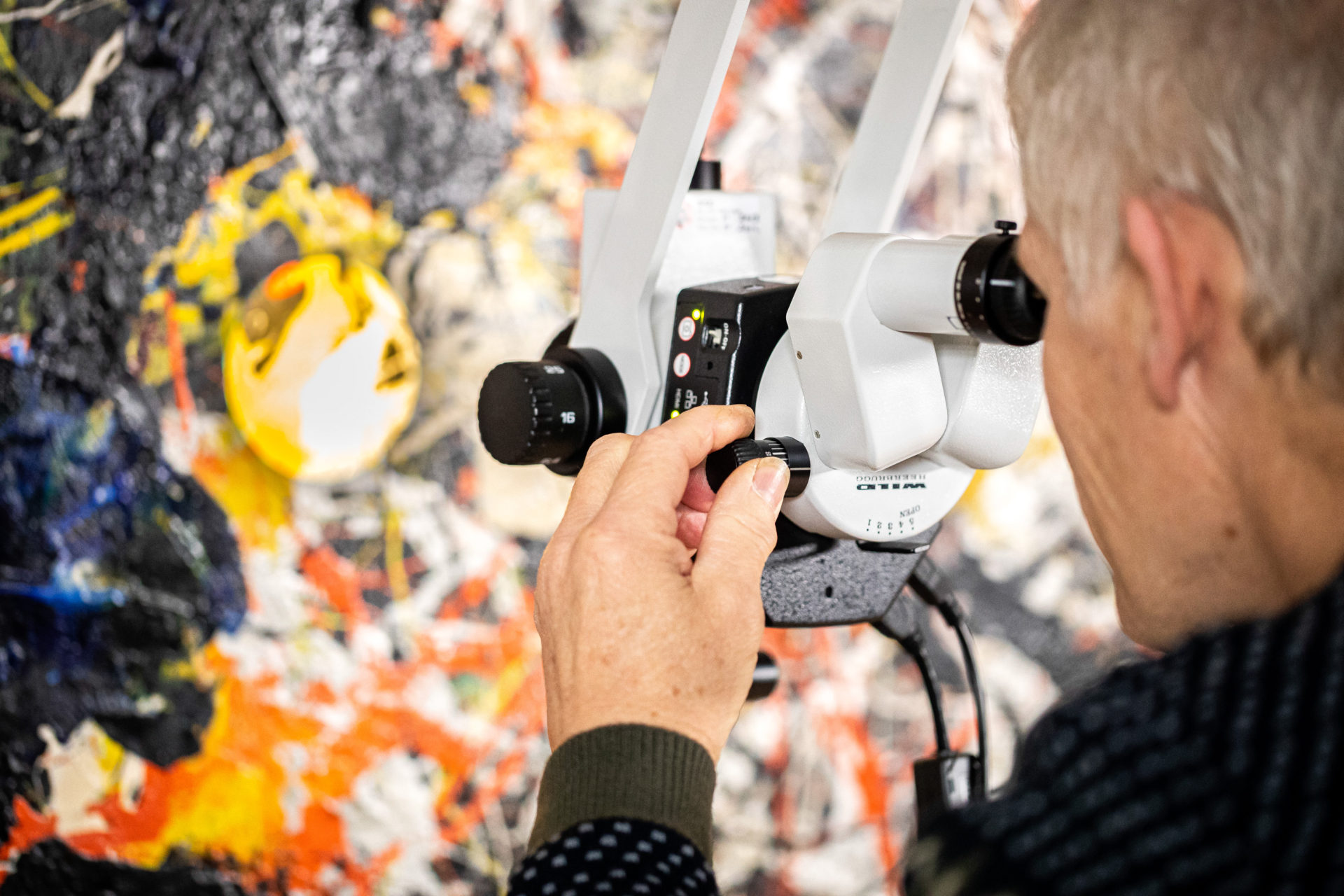Based on questions from visitors to the National Gallery during live sessions of conservation on Blue poles in 2020, we’ve collated some of the most pressing questions about Jackson Pollock and Blue poles.
In regards to the canvas, did Pollock prime the canvas or is there another painting under Blue poles?
For Blue poles, Pollock used a highquality Belgian linen with a commercially oilprimed ground. The many, many layers of paint – and the different drying times – are witness to Pollock’s ‘campaigns’ with the work. Blue poles is a work that he re-entered many times and, as the artist himself said, took a ‘long time to come out’. But, no, there’s no other painting underneath.
Do we know if Pollock’s style was to have the finished piece envisaged when he started a work or if he just let the piece take him wherever it was going to take him?
Pollock was rather reticent and rarely talked directly about his work, unless it was to discuss his technique, or to observe that modern art is not dependant on subject matter – painting, he said, comes from ‘within’, expressing ‘the energy, the motion and other inner forces’.
Instead we tend to consider Pollock’s broader motivations and influences including European surrealism, analysis and American indigenous art, as well as jazz and the city, Mexican mural painting, and the wide open spaces of the United States of America, such as the Grand Canyon and, later, the vistas of Long Island and tides of the Atlantic Ocean.
From the way the paint has been applied, and the numerous overlaying layers it is obvious that he reworked the surface further suggesting that the painting evolved over time.
Have Pollock’s fingerprints been found in his other works?
Yes. Number 1A ,1948 1948 (Museum of Modern Art, New York), for example, includes several handprints at upper right. Number one, 1950 (Lavender mist) 1950 (National Gallery of Art, Washington) is likewise ‘signed’ with handprints at the upper left and right corners.
How much does it weigh?
The overall weight of the work is 99 kgs but a good part of that is the heavy-duty stretcher and other infrastructure that keeps the canvas stable and protected – the aluminium bracing, backing board and frame. As the original canvas has also been lined onto a further canvas, before it was acquired by the National Gallery, it is difficult to estimate the weight of Pollock’s original canvas and paint layer. Due to the excellent structural stability of the work we do not anticipate that we would need to remove the canvas from the secondary supports in the near future and so we are unlikely to be able to test the true weight of the canvas, without all of the ancillary supports.

Is it Pollock’s fingerprint?
We don’t know for sure, but it seems most unlikely to be anyone else’s! Several attempts have been made to link works to Pollock based on fingerprints on paint tins in the artist’s studio. We haven’t gone down this track. In this case we rely on provenance (history of ownership) and other less contested fields.
What is involved in conserving Blue poles? Do you make repairs? Repaint sections?
The conservation of a work is a complex process and is driven by the needs of the painting itself. The aim is to present the painting with all due respect to the artist’s original intentions. Any treatments are carefully considered in terms of maintaining the stability of a work and its cosmetic appearance. Treatment is part of the long-term strategy of care for the collection which involves preventive conservation, environmental control and periodic maintenance.
Did he use similar paints etc on Blue poles to what he used on works like Lavender Mist?
Yes, many of Pollock’s drip paintings or ‘all-over’ works from the period 1948–50, and subsequent canvases such as Blue poles, are consistent. Pollock was painting before the availability of acrylic paints, so the majority of paints widely in use were still based on drying oils. Commercial oil paints were modified in various ways to make them easier to use and more hardwearing when applied to furniture, doors, car bodies etc. Pollocks drip technique benefited from these modifications as they altered the flow and drying properties of the paint when compared to traditional artists’ oil paint. This meant that he could apply the paint in non-traditional ways to achieve the loops and strands characteristic of his later work.

Can we still view Blue Poles while it’s undergoing analysis and conservation?
Yes, the painting in on display in the International galleries on level 2, and is visible during opening hours, albeit with some equipment that visitors wouldn’t always see.
On Wednesdays, 1.30–2.30pm, Senior Painting Conservator David Wise, and Senior Curator of International Painting and Sculpture Dr Lucina Ward are available to answer questions about the project.
Do you ever do private collection conservation works? What would happen if this painting were to be privately owned?
National Gallery Conservators are committed to caring for the National collection. While we may occasionally treat works on loan to us for specific exhibitions, with the lender’s permission, this is not a routine part of our duties. There are a range of trained and experienced conservators working in private practice who operate on a fee for service basis and many are closely engaged with the care of private collections.
Will you be doing this in depth with any other works?
National Gallery conservators are always busy behind the scenes in the lab. As you can imagine there’s a huge and ongoing program of work on the collection! The particular circumstances of Pollock’s Blue poles – its dimensions, its prominence within the collection and the fact that its constantly requested – mean that we thought it best to continue the work within the galleries, but we hope to bring more conservation action to public attention. It’s a fascinating field.